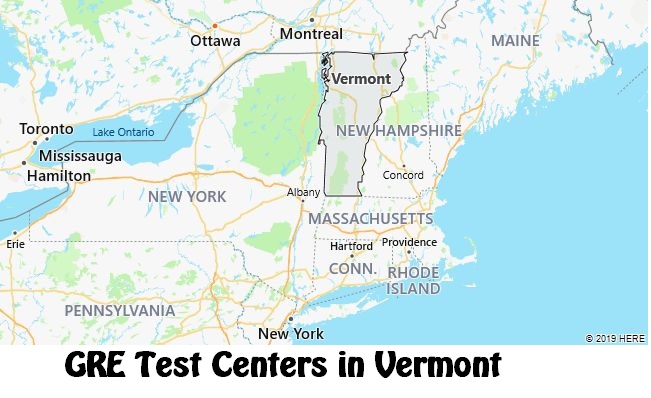GRE Testing Locations
Decided to take GRE exam? Now it is time to determine where to take the test. This site provides a full list of GRE testing centers in Vermont, among which, you can choose one that is nearest to you. Good news is that the following GRE test locations in Vermont offer both GRE general test and the GRE subject tests.

- Burlington – Williston – APCN-5209
600 BLAIR PARK RD, SUITE 326, WILLISTON
Vermont United States 054957529
Computer Based Test
GRE Test Dates
There are two types of test format offered by the test maker – ETS: Computer-delivered and Paper-delivered GRE general tests. For computer based test format, the GRE General Test is offered year-round on a continuous basis, and available for registration on a first-come, first-served basis. For paper based general test, testing is available three times per year. The following test dates apply:
| Test Dates for Paper Based | Deadlines for Registration | Scores Available |
|---|---|---|
| November 09, 2019 | October 4, 2019 | December 20, 2019 |
| February 1, 2020 | December 27, 2019 | March 13, 2020 |
GRE Subject Tests in Vermont
The GRE Subject Tests are available on paper based only. In all GRE test centers throughout the world (both inside and outside United States), the exam is available three times a year. The three test dates are:
- April
- September
- October

Nature of Vermont
The state of Vermont is located in the Northeastern United States and belongs to the states of New England. Vermont is one of the smallest US states, its territory is 24,923 km 2 (45th place in the United States of America).
Vermont borders Canada to the north, New Hampshire to the east, Massachusetts to the south, and New York to the west. Vermont is the only New England state that is landlocked.
The state of Vermont belongs to the US Eastern Time Zone.
There are several major physiographic regions within the state of Vermont: the Lake Champlain Valley, the Taconic Mountains, the Green Mountains, the Vermont Valley, Vermont’s Piedmont, and the Northeast Highlands.
In southwestern Vermont (as well as neighboring Massachusetts and New York) stretches the Taconic Mountain Range, part of the Appalachian mountain system. Its highest point is Mount Equinox, at 1,175 meters above sea level.
In the northwest of the state lies the valley of Lake Champlain, a vast lowland with fertile lands. To the south (and east of the Taconic Mountains) it passes into the narrow Vermont Valley formed by numerous small rivers and streams.
The Green Mountains stretch across the central part of the state from north to south, into Massachusetts. This is a mountain range that is part of the Appalachians, the highest peak of which is Mount Mansfield (1,340 meters). Due to its characteristic profile, Mount Camels Hump (“Camel’s Hump”, 1,244 meters) is also widely known.
It is in honor of this mountain range that Vermont got its nickname – the “Green Mountain State”.
The Appalachian Trail, extremely popular with hikers and one of the most famous attractions in the United States, passes through the Green Mountains. This tourist route starts in Georgia, traverses North Carolina, Tennessee, Virginia, West Virginia, Maryland, Pennsylvania, New Jersey, New York, Connecticut, Massachusetts, Vermont, and New Hampshire to America’s most northeastern state, Maine.
The largest region of the state is located east of the Green Mountains in the Western Highlands of New England, also known as the Piedmont or Vermont Foothills. It is a hilly plain with numerous rock outcrops and lakes. It is here that the Connecticut River flows, along which the border between Vermont and New Hampshire passes. Gradually rising to the east, Vermont’s Piedmont passes into the Northeast Highlands, a mountain range whose height exceeds 1,000 meters.
In Vermont, with its very rugged relief, not very suitable for agriculture, quite large territories have been preserved that have not been affected by human economic activity. Almost 80% of the state is covered with forests, among which is the well-known nature reserve – the Green Mountains National Forest.
The territory of Vermont belongs to the region of humid continental climate, milder in the valley of Lake Champlain and much more severe in the Northeast Highlands, in the so-called “Northeast Kingdom” area. In general, the state is characterized by warm, humid summers, during which the main amount of precipitation falls, and frosty, snowy winters. As a rule, snow in Vermont covers the ground for at least three months, although there are thaws.
The average temperature of the coldest winter month, January, in the central Vermont state capital, Montpelier, ranges from -14°C to -4°C. The hottest summer month, July, is characterized by average temperatures ranging from 14°C to 26°C. In Vermont’s largest city, Burlington, to the west in the Lake Champlain Valley, temperatures range from -12°C to -3°C in January and from 16°C to 27°C in July.
Like all of New England, Vermont is famous for its extraordinarily beautiful autumn, when the state’s picturesque landscapes attract many tourists.
